 This article highlights a PYP school’s journey towards fostering language and literacy inquiry as an essential tool for achieving the objectives of the programme of inquiry and ultimately, learner success.
This article highlights a PYP school’s journey towards fostering language and literacy inquiry as an essential tool for achieving the objectives of the programme of inquiry and ultimately, learner success.
“All teachers in a PYP school are considered teachers of language.”
Making the PYP happen, (2009) p. 68.
A strong statement that convicts us as PYP educators – language drives what we do, how we do it and what results we obtain in teaching and learning. How simple in its essence and how powerful in its message, but often how complex in its implementation.
Over the past four years, our school journey has called us to challenge how we view language and literacy instruction and learning within the context of the PYP. We asked ourselves a hard question, “Is what and how students are reading and writing encouraging them to deepen their understanding of the essential elements?” This uncomfortable yet invaluable reflection led us to analyze our teaching practices, resources that we use, student learning outcomes and expectations, assessment strategies and reporting of student progress.
Through discussions, expert consultation and research, we began to learn more about ourselves as PYP language teachers and our students as language learners. We determined that reading stories about topics related to the unit did not drive students into deeper conceptual understanding. Superficial or short-term writing activities did not allow students to demonstrate their understanding in a deep and enduring way. After much debate and introspection as a school, we came to the conclusion that big adjustments needed to happen for literacy to become much more immersed as well as evident in our units of inquiry. Fantastic conclusion, but what did that mean in terms of action?
How will language lead our students to a deeper understanding of the essential elements?
The first action step was to determine the answer to a fundamental question, “How will our language instruction best support each unit of inquiry?” We looked at central ideas and concepts, genres and the writing process, reading materials and provocations, rubrics and assessments. From there, we began to make decisions. The more we looked at language through the lens of the essential elements, the more we found that language absolutely had to be a forerunner in how students moved through the programme of inquiry.
We found that 2nd grade students inquiring about creativity as a tool to express and create showed a greater depth and breadth of knowledge and concepts when we immersed a genre study on reading and writing fiction into the unit of inquiry. As they discovered different mentor authors, they not only grew as young readers, but began making calculated decisions and actions as writers. As they explored common attributes among stories, they determined how they could use these skills together with their own creative license to create their own original authorial works. 5th grade students inquiring about energy existing in different forms were able to express their understanding of the related concepts of energy, use, and conservation as well as key concepts of form, function and responsibility through nonfiction books that they carried through the writing process. They acquired knowledge through exploring nonfiction books on energy from the classroom library using reading skills like questioning, summarizing, note-taking, and forming conclusions. Another residual but positive effect of this change was the huge growth students showed in self-management and self-directed inquiry.
What has been the outcome on student learning?
These are just two examples of a trend that has repeated itself at each grade level. In the four years that we have lived this transition as a school, students’ language skills have exploded. The quantity and quality of what they consume and produce as language users has grown exponentially. Their lives as young authors have become drivers of the inquiry and tools for the construction of conceptual understanding.
Teachers had always been accustomed to building vertically on students’ prior knowledge and skills within the context of the transdisciplinary themes and subject areas of social studies and science. As teachers and administrators, we have found that now that literacy is immersed into the units of inquiry, we are able to enhance students’ purposeful usage of their language skills in a much more natural and significant way.
What happens next?
While these steps have allowed us to grow as a school in PYP language and literacy, as is always the case in our work as educators, this is not the end. Change inevitably invites us into deeper examination of other areas related to curriculum. The task before us is to continue this self-reflection and exploration of language and the ripple effect it has on who we are as a PYP school. This will involve a new revision of scope and sequence documents in order to ensure that the conceptual understandings and conditions for learning are evident in both target languages of the school. We will also review our language policy to be certain that it not only reflects what we believe as a school but also, outlines how we guide students to deep inquiry and lasting understanding through literacy and language. Whatever other changes come from this first step, we use the knowledge we’ve gained about the depth and power of our students’ learning as motivation to continue the journey as teachers of language.
—
Shannon has been a PYP educator for 10 years. She has served as both a classroom teacher and her current role as coordinator of the English programme at the Puebla American School Foundation in Puebla, Mexico. Her passion in literacy and inquiry has aided as the school adopts and adapts the balanced literacy framework within the context of the PYP. You can follow Shannon on Twitter @shannonandav.
